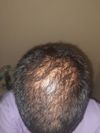community 27M, 1.5 years of topical fin, min and saw palmetto, sometimes microneedling. Not there yet, but I feel like I have definitely made some progress so far!
Hair loss treatment using topical fin, min, saw palmetto, and occasional microneedling shows progress after 1.5 years. Microneedling frequency varies from weekly to every 4-5 weeks with 1.5mm needles.
